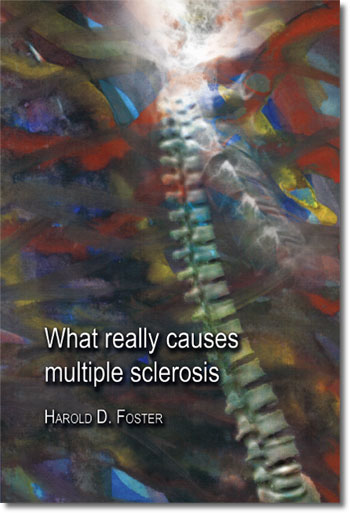
What Really Causes Multiple Sclerosis
a book by Harold D. Foster
[pdf] What really causes multiple sclerosis
218 pages; quality trade paperback (softcover); catalogue #07-0045; ISBN
1-4251-1636-1; US$19.35, C$22.25, EUR15.89, £11.13
The fourth volume in the *What Really Causes...* series providing a new hypothesis on the causes, prevention and treatment of Multiple Sclerosis.
Taken as a whole, the available scientific and alternative evidence suggests that multiple sclerosis patients suffer from chronic inflammation caused by diets that contain inadequate antioxidants, omega-3 deficiencies, excess sugar, and foods that fail to significantly reduce oxidative stress. In addition, gluten, cow's milk, or some other allergen further promotes autoimmune disease. The coupe de grâe, however, is a thyroid hormone deficiency that causes an abnormal need for dopamine. Dopamine is very susceptible to oxidative stress and can break down to form toxins such as dopachrome and other chrome indoles. These, in turn, kill oligodendrocytes, the cells needed to repair the damage to myelin caused by chronic inflammation. Beyond this, a shortage of triiodothyronine in multiple sclerosis patients appears to reduce their ability to produce new oligodendrocytes. Therefore, myelin deteriorates and the symptoms of multiple sclerosis worsen. Wilcoxon and Redei have shown that such associated thyroid malfunctions in adults may be triggered by environmental challenges early in life. This process is termed fetal programming.
If the three step hypothesis presented in this book is correct, then it is possible to prevent and reverse multiple sclerosis. However, to achieve such goals requires societal and individual commitment. This volume concludes with an outline of the strategies that are needed. These include promoting anti-inflammatory diets and methods for avoiding the allergens that trigger inflammatory cascades and associated chronic auotimmune disease. Also discussed are orthomolecular techniques for mitigating the negative impacts of the neurotoxins associated with the oxidation of excess dopamine and for stimulating the body to produce higher levels of antioxidant enzymes, such as glutathione peroxidase. In summary, this book provides new evidence on the causes of multiple sclerosis and offers approaches for reversing its impacts.